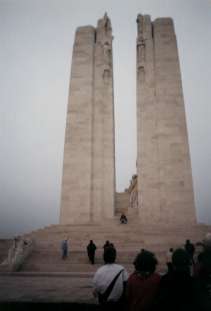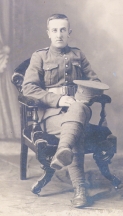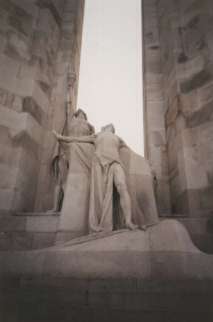VIMY RIDGE

In 1917 Vimy Ridge,a scarp
near Arras in France, was held by the Germans. It is now a milestone
in Canadian history. On April 9, 1917 100,000 soldiers of the
Canadian Corps attacked Vimy Ridge and took it from from the Germans in a bloody
battle which began at 5:30 a.m. and lasted two days. At the time this
appeared to be an amazing feat, for Canada was considered a
backwoods country, very small in population, and still tied
to the apron strings of Great Britain. The Germans had
held Vimy Ridge for three years, and earlier attacks
had caused a loss of 200,000 men - Germans, British,
French and Canadians. In the battle of Vimy Ridge,
the Canadians suffered 10,000 casualties but achieved
what the British, French and Germans thought was
impossible. Pierre Berton, in Vimy, said "Vimy
convinced the Canadians that they were the finest
troops on the Western Front".
In 1922 the government of France gave 250 acres of
Vimy Ridge, in the area of Hill 145, the highest point
of the ridge, to Canada to be used as a memorial park.
The architect who designed the monument was Walter
Allward. The twin spires, each 226 feet in height,
represent the countries of Canada and France, and the
towering monument can be seen for miles around.
There are twenty sculptured figures on the monument
and the names of 11,285 Canadians missing in France
are carved on the walls. The monument took ten years
to build and was unveiled on July 29, 1936. Over 6,000
Canadians crossed the Atlantic on five ships to attend
the unveiling.
I was very privileged to be able to take twenty-three
of my History students to Europe in March, 1997. Although
Vimy Ridge was not a scheduled stop on our way from
Calais to Paris, I requested that we make a short visit
there. Our tour guide gladly agreed, but told us that
he had never been there before, having never had
Canadians on his tours before, only Americans.
It was about 3:00 p.m. on March 4th that our bus
rolled down Canada St. in Arras on our way out to the
Ridge. What an impressive sight when we approached
from the bottom of the ridge and observed the Canadian
War Memorial looming up above us!
Our time was limited, as supper awaited us in Paris.
There were only two school groups there that afternoon,
our group and a group from Quebec- quite deserted that
time of year. We knew that a young man from our
village had been killed at Vimy and found his name on
the monument.
His name was
Carl Ingalls and he was the son of Turner
and Clarinda (McLaughlin) Ingalls, born March 25, 1896
at a lighthouse, a few miles south of the small
fishing village of Seal Cove on the Island of Grand
Manan in New Brunswick. Many young boys and men on this
small island answered the call to arms in World War I
and thirteen of them never returned. Carl's fate was to
be one of the 100,000 who attacked Vimy Ridge and
died there in the heat of battle, barely twenty-one
years of age.
CARL INGALLS
In Nov. 1917, Carl's aunt, Julia Mulneaux was interviewed by the "Eastport Sentinel" on the occasion of her eightieth birthday. Mrs. Mulneaux's father had fought with Wellington at the Battle of Waterloo and the newspaper stated that "It's in the blood, for two nephews have crossed the Atlantic to defeat the Kaiser, and more distant relatives from Grand Manan have unsheathed their swords against warlordism".
It goes on to say that the folLowing letter eluded the U-boats to bring comfort to the home of Carl Ingalls after his death:
"Somewhere, June 29, 1917
Dear Madam:
We are in receipt of a parcel addressed to your son who was killed at Vimy. We have taken the liberty of dividing up your gift among the friends of your boy and we hope this will meet with your approval.
May I say one word about Carl? In spite of his youth he was a real man who never faltered in the path of duty. As you know he won the military medal, though he never lived to wear it.
In the rush and change of war it is but human for the officers not to remember every man, but now and then the heroism of some one boy makes him an outstanding figure and his memory helps us all to be the stronger and better in this greatest struggle.
Assuring you of our deep and sincere sympathy, I remain,
No signature, no address, just "somewhere" under the pitying omniscient stars. But on the back was the cryptic: J.D. Macintyre,Lieut. for O.C. "6"Coy."

View from the front of the monument
The following are photographs of the Monument taken by Harry Palmer.
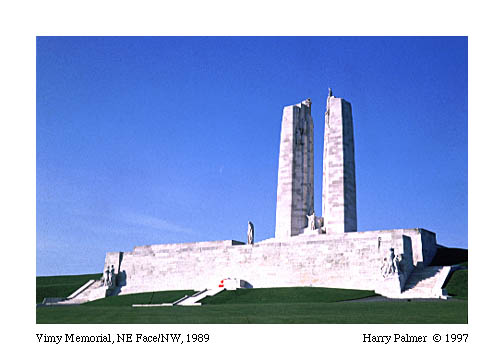
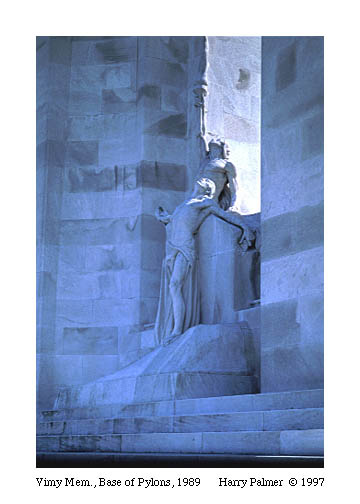
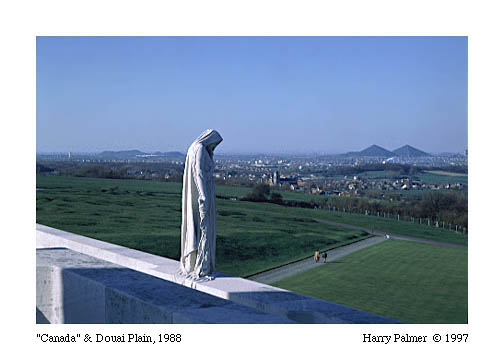
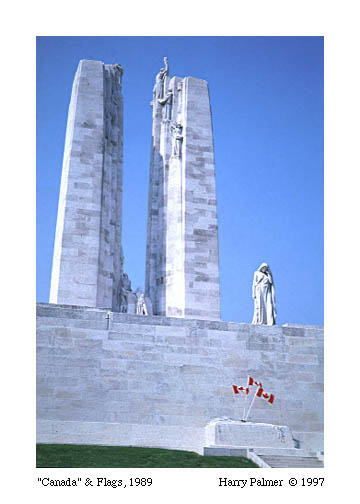

HOME

